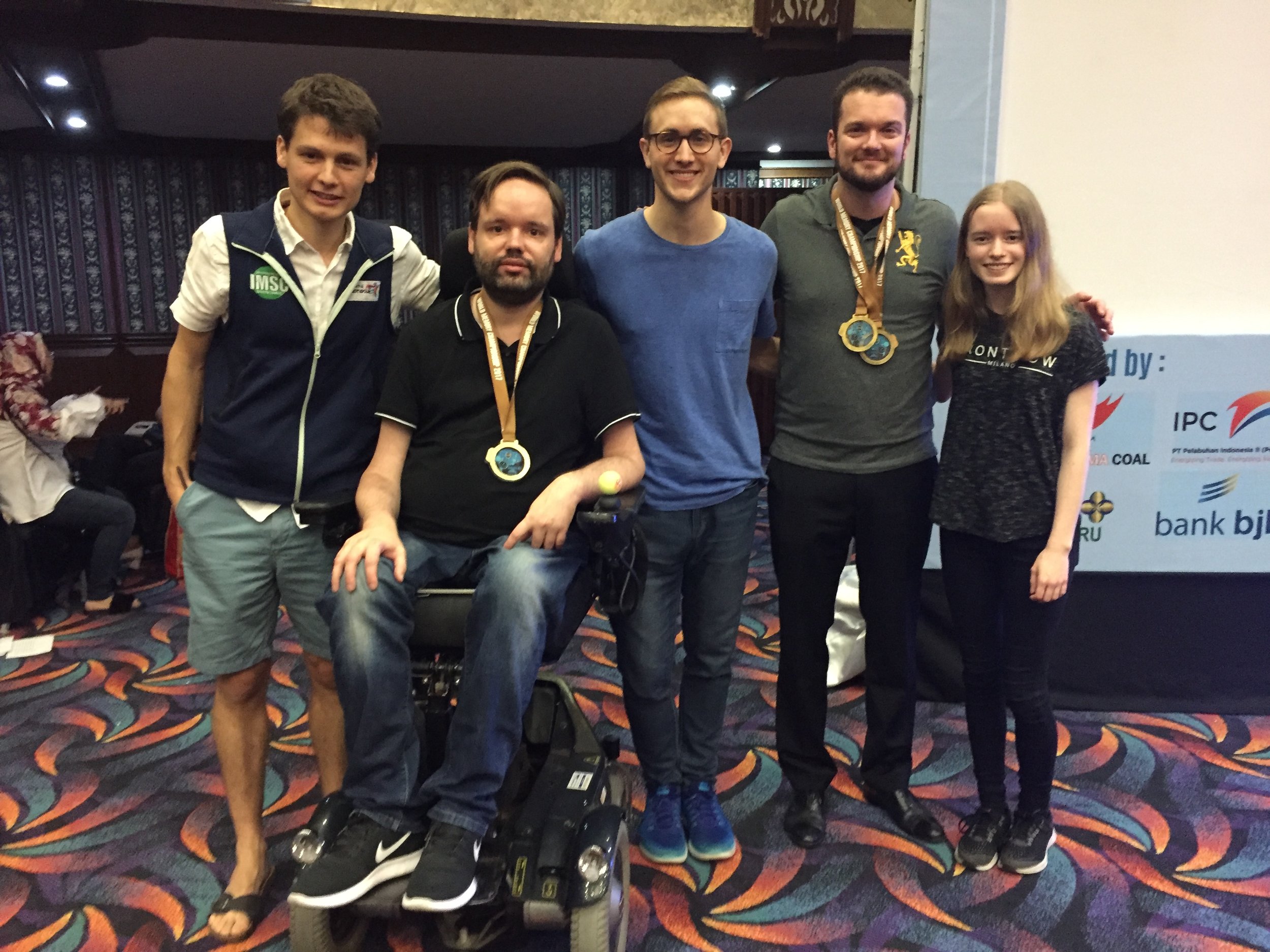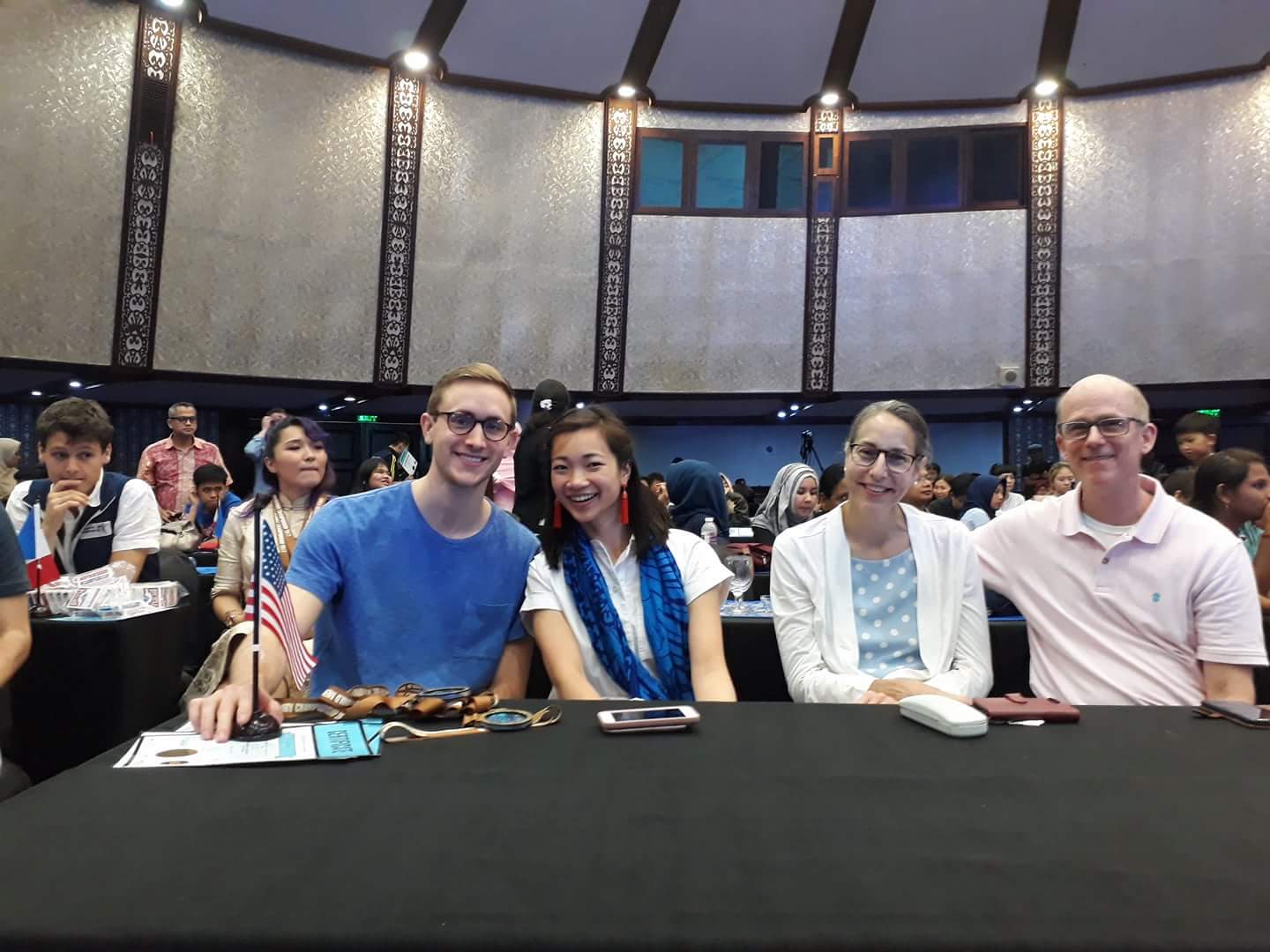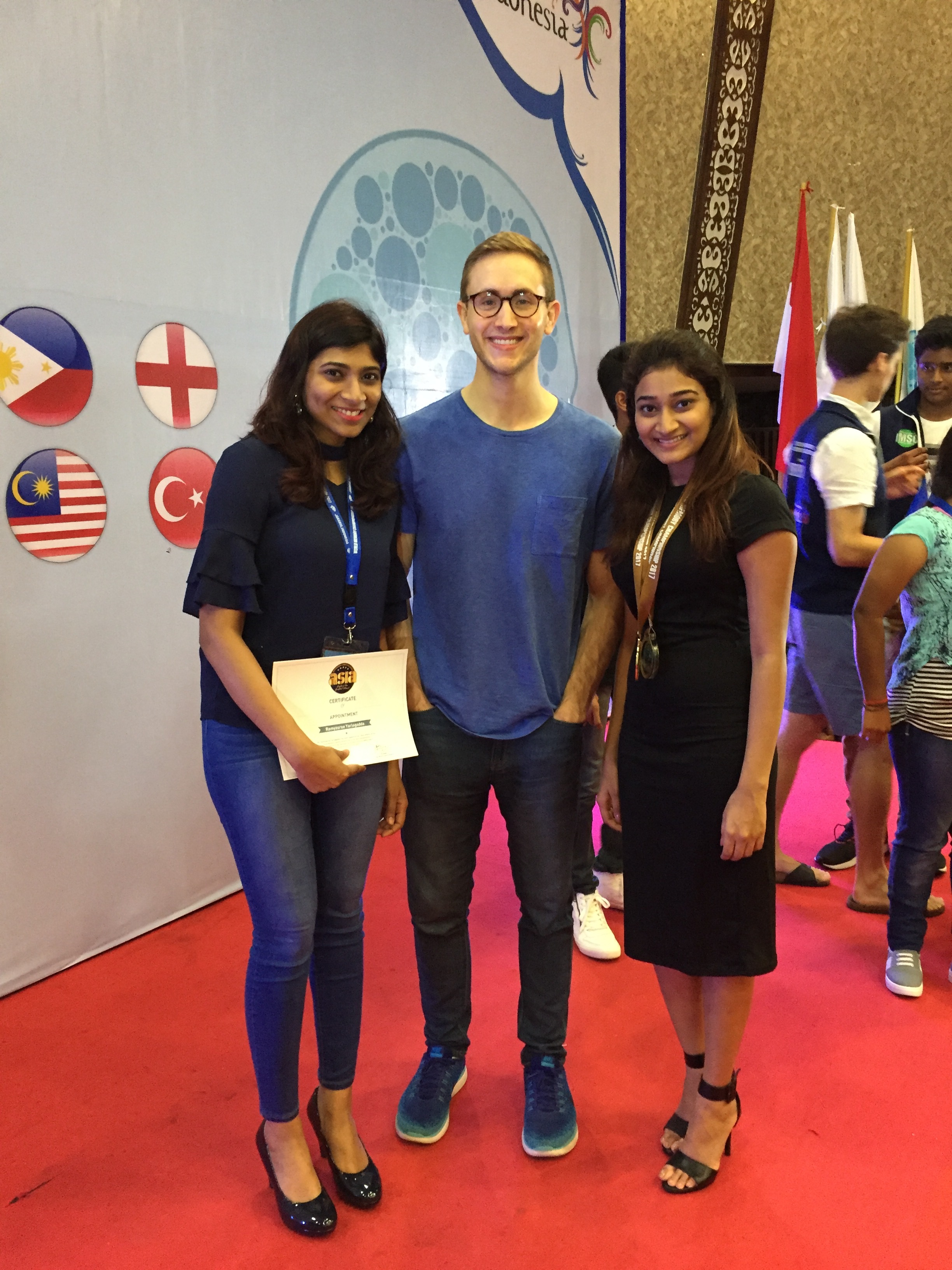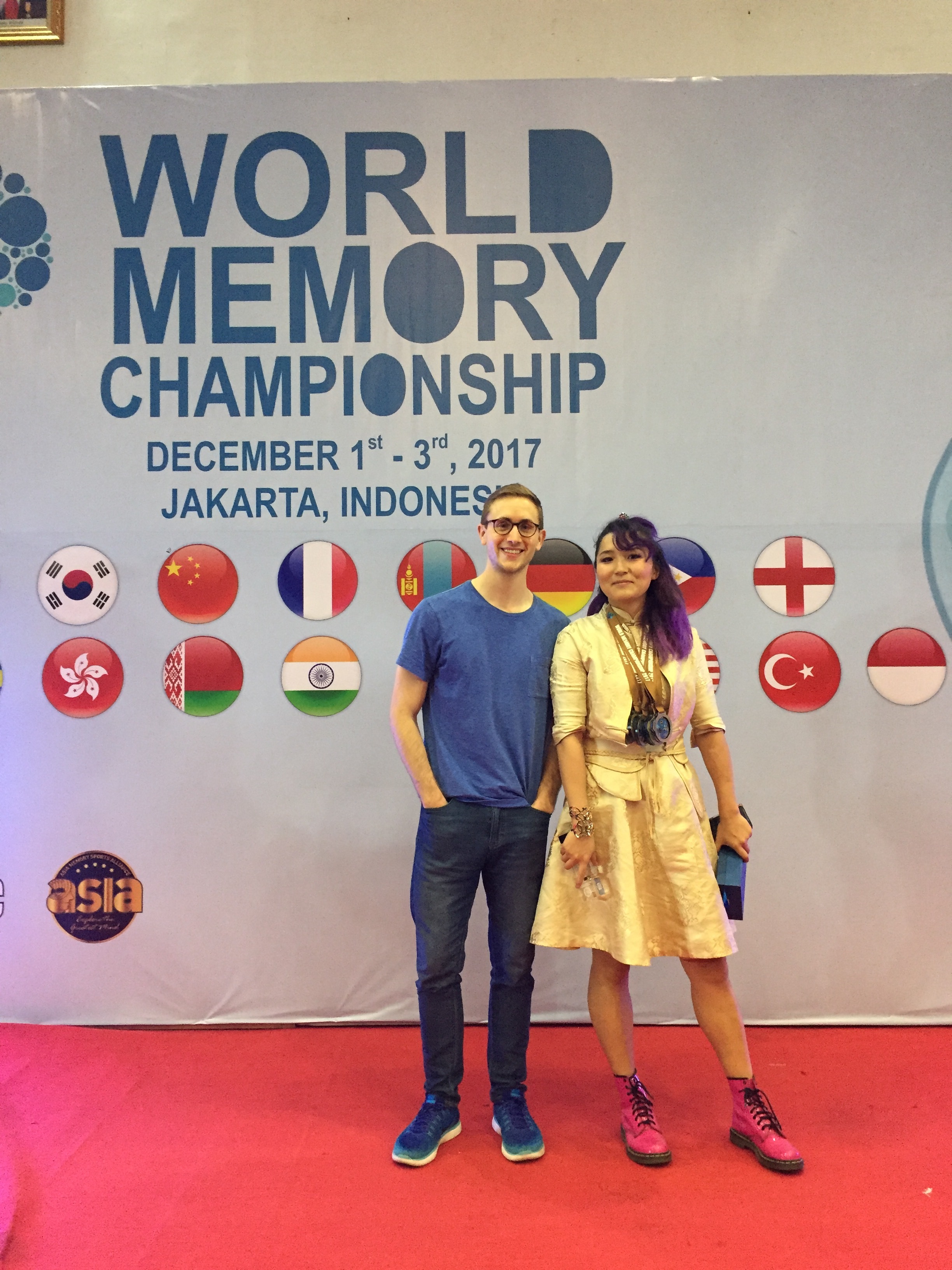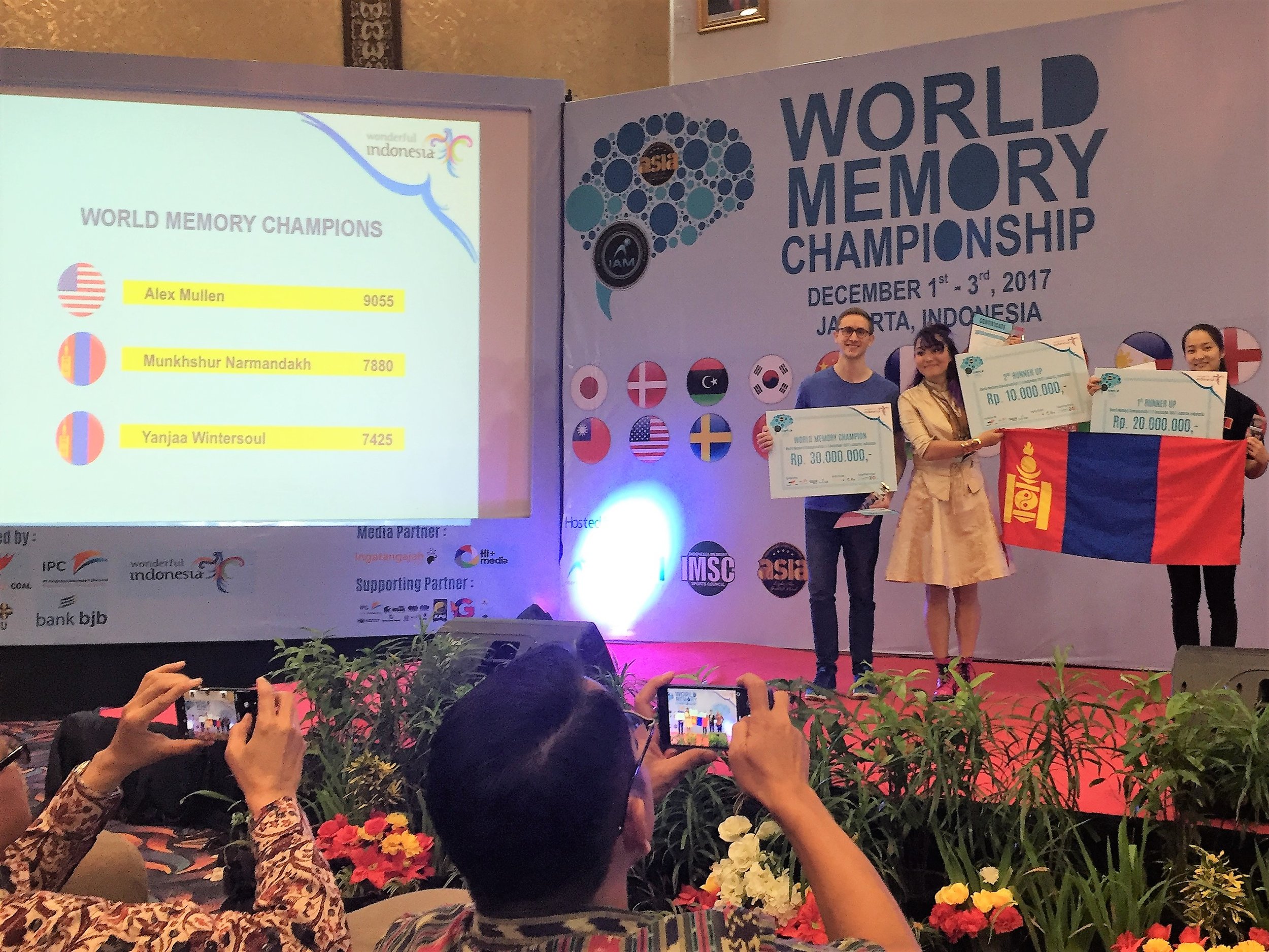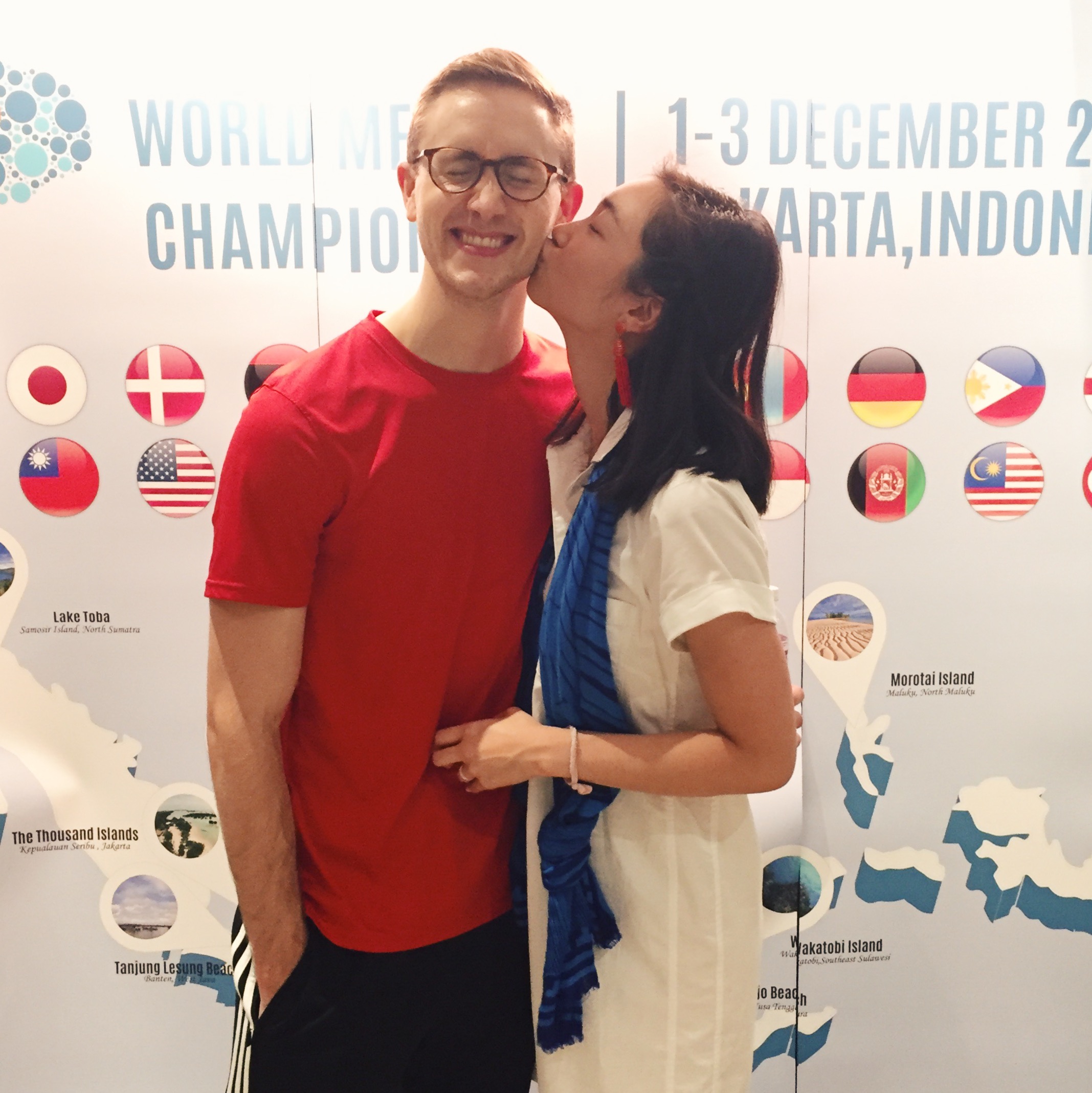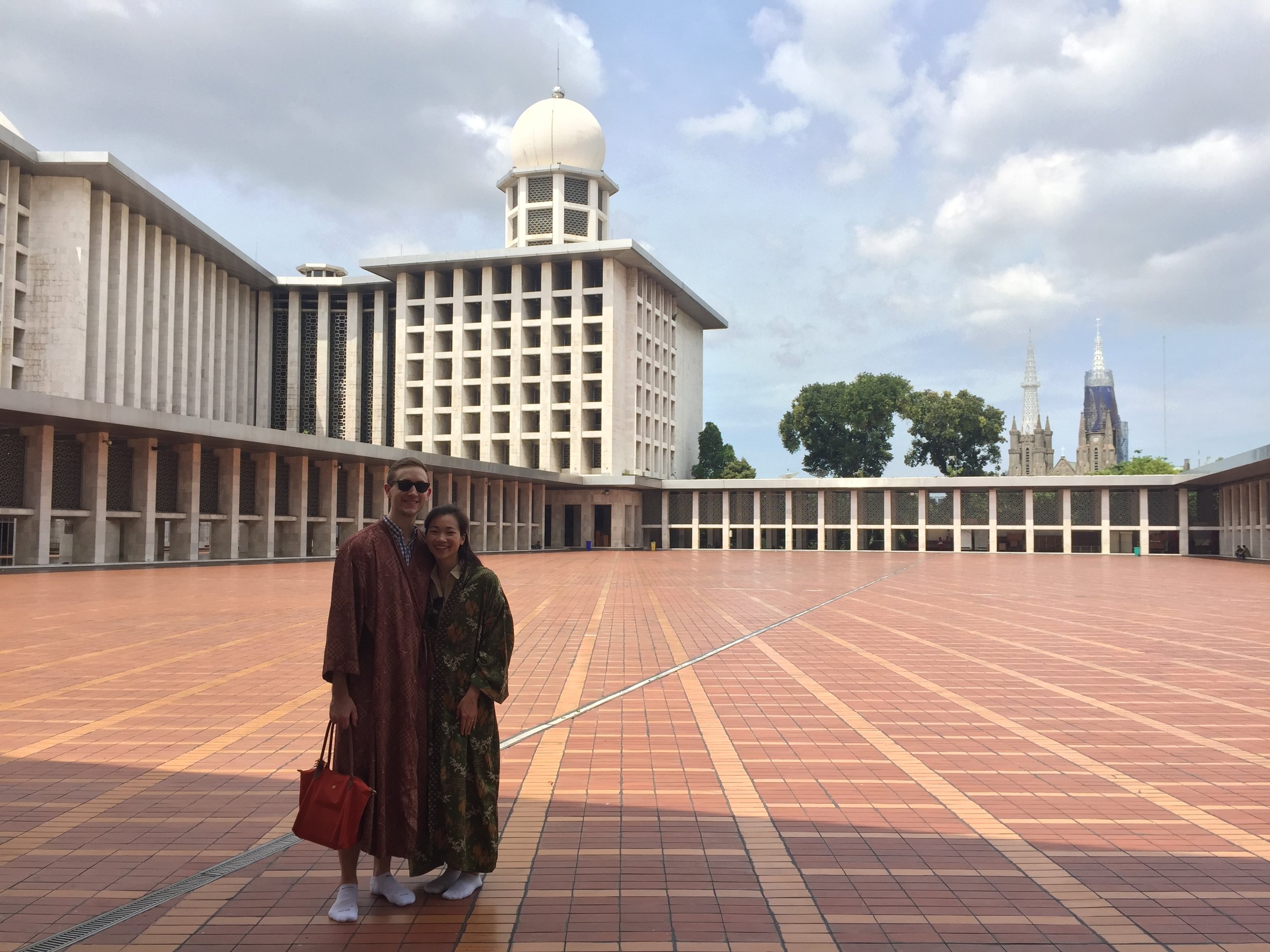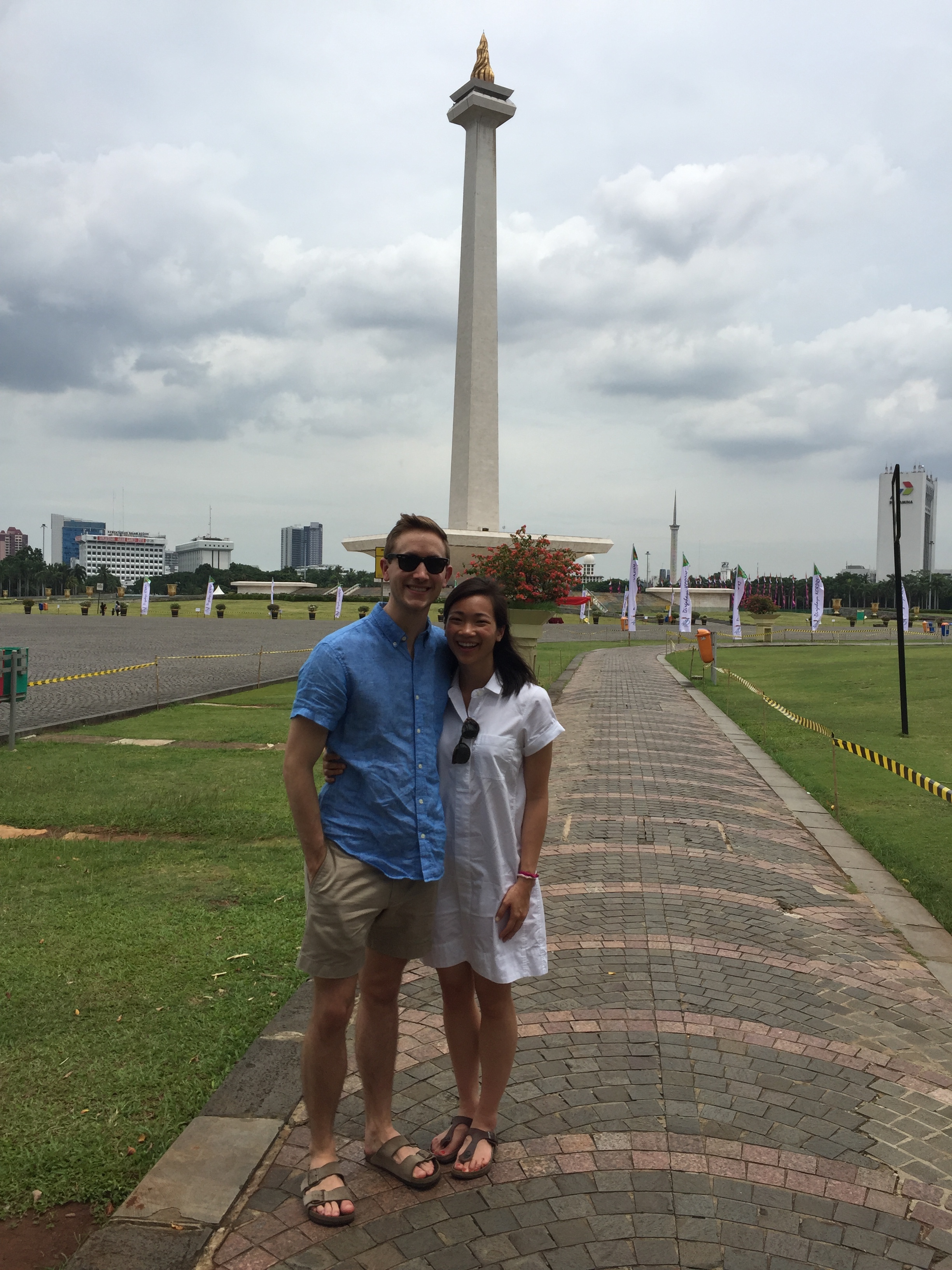~150 competitors from 20+ countries
WMC No. 3! I’m home after three long weeks—a Florida wedding followed by the 2017 IAM World Memory Championship in Jakarta, Indonesia.
At The Breakers, Palm Beach, Florida
I can’t resist giving a shoutout to my friends Saumya and Khush for an awesome wedding week. Those guys know how to throw a party! After five days in Palm Beach, Cathy and I hopped back in a plane trying not to think about how we’d be spending the next 50+ hours traveling. Fort Lauderdale to Memphis, to our hometown of Oxford for a night, back to Memphis, to Atlanta, to Tokyo, to Jakarta. A slew of Silicon Valley, Modern Family, and Last Week Tonight episodes later, we were riding through the hot Indonesian night with fellow American competitor John Graham, Mongolian competitor Yanjaa Wintersoul, and WMC organizers Yudi and Bey.
After two days of milling around the city—seeing the National Monument and an Indonesian puppet show, among other things—I found myself face-to-face with another WMC. Things were destined to be different. First, the field toughens every year. Eight of the top ten memory competitors in the world—excluding Chinese competitors Su Zehe and Gan Kaoyuan—were converging in Jakarta. The Narmandakh twins of Mongolia, Munkhshur and Enkhshur, looked especially strong. Second, this would be the first world championship hosted by the International Association of Memory (IAM). A big deal. If you missed it, you can read more about the split here and here. The World Memory Sports Council (WMSC), who’d hosted uncontested WMCs for 25 years, would be holding their 26th event a few days later in Shenzhen, China, to a field of predominantly Chinese competitors. (I later learned the Mongolian team would attend both championships. Munkhshur won.)
IAM or not, I never know what to expect heading into a WMC. Adding to the uncertainty, I hadn’t competed all year. In 2016, during my year off from school, I was fortunate to attend Memoriad and the IAM European Open in the leadup to the WMC. No such warmup this time.
I had been able to train throughout the year, albeit most of it via sprint events on Memory League. ML-type events are easily my favorite form of training, so I followed my interest. With my third year of med school, I hadn’t really expected to attend this year’s WMC. By some miracle, my rotation schedule had an elective overlapping the championship. By another, one of my school’s rotations was completely canceled, leaving me a two-week break in the Spring. After some finagling, I got that break swapped with my elective, leaving Dec. 1-3 open.
As the date loomed, I put in five weeks of WMC practice, juggling training and a psychiatry rotation. Returning from the hospital around 4 each day, I’d train for ~1.5 hours, using the weekends for the hour disciplines. Although happy with my progress given my workload, I couldn’t help but feel out of touch. Nevertheless, I resolved—as I always attempt but rarely succeed—to just enjoy myself. I’d done my best to prepare. Whatever happened, happened. However, despite my best efforts to ward off nerves—meditation, self-talk, nihilism—my body has a way of not listening to me and doing whatever it wants. You’d think years of competing and two world championships would allay that. But nope, still nervous.
Day One: 30 Minute Binary, 15 Minute Names & Faces, Hour Numbers
Thankfully, the buildup was, as always, worse than the thing itself. Due to an Indonesian Muslim holiday, binary had been swapped with names and was now the kick-off discipline. Munkhshur had trampled Marwin’s once-impeccable record of 5,040, racking up 6,270 at this year’s Asian Open. My previous best had been ~4,200, and I’d felt this might be nearing my peak. Inspired by the rising records, I’d pushed to well over 5,000 in training. Nothing fundamental changed. I still used a 3x3 block system placing two images per locus. I just gave myself permission to move faster and review less. It’s funny how memory sports work.
Normally, I like having names first as a way to warm-up with one of my weaker disciplines. Having a marathon first—where rhythm, pacing, and review matter more—was disconcerting. Complicating things was the fact that I was coming off two weeks break. Apart from drills, I hadn’t trained. Heading cold into binary, I needed to strike that balance between speed, control, and attention. I didn’t read quite as many as I’d hoped, but fortunately, I hit the nail close enough to the head. Thanks to the IAM arbiters’ swift scoring and online updating, we had results by the afternoon. 5,235 digits, good enough for 3rd— Munkhshur 5,730, Enkhshur 5,325. A solid start. I’d have been satisfied keeping the gap less than 1,000 here.
Names followed. N&F was one of two events in which I hadn’t made much progress in training, and I found this batch especially hard. I only managed 116. In retrospect, I should’ve trained more paper names, as inconvenient as it is. Far from my best, but a relief considering the difficulty. Yanjaa and Simon Reinhard encountered no such difficulties and cranked it out of the park. Yanjaa broke Katie Kermode’s record of 200, scoring 212. Simon did 186, a competition best for him.
After lunch, we dove back in for hour numbers. My least favorite event, always has been. I like sprint numbers, but hour is long, repetitive, and error-unfriendly. Feeling in a rut and throwing caution to the wind, I’d experimented in training. Different review strategies. Different speeds. Sometimes reading 3500, sometimes 4500. As the competition approached, I psyched myself out and backpedaled to a safer strategy. This event also came with the nauseating pang of realizing my transparency, which fits a box around every three digits, didn’t match the paper. The organizers ultimately printed a new paper with the boxes already placed. Here’s hoping the IAM institutes this worldwide soon. All they’d need would be a few options: blank, 2-digit boxes, and 3-digit boxes, for starters. It’d make things so much easier! To their credit, the organizers acted decisively, so the complication didn’t throw me too much. Reading a too-safe 3600, I recalled well, giving me 3,238 after the cutting room floor. Nothing explosive, but good enough for first place and a small bump in the WR.
A satisfying if unspectacular start. I couldn’t have hoped for much better. I’d put together improvements in binary and numbers for a 52-point lead over Munkhshur.
Day Two: 5 Minute Images, 5 Minute Numbers, Historic Dates, Hour Cards
With two marathons out of the way, the fun was finally getting started. Day 2 has always been my favorite WMC day. The tedious events are in the bag, and the pressure of crossing the finish line hasn’t set in.
We got things rolling with 5 Minute Images, an event I’d never done before in competition. The IAM had replaced the WMSC’s poorly-realized “abstract” images with “concrete” images. (Competitors discovered a glitch in the image generation so that they only memorized the background texture, ignoring the abstract shape. The entire point of the event—to test abstract memory—was lost.) The move kept the unique structure of the event (rows of 5) while replacing the silly bit. I applied my old abstract strategy: 2 images per locus, ignoring the 5th image. Unfortunately, my lack of competition experience showed. I’d a made a noobish training error that turned out to bite me: I’d never trained with paper. “Oh, I’ve done this plenty of times with abstract… It’ll be fine,” I’d told myself. I reacted slowly to the paper, reading only ~80% of what I’d trained for digitally. Recall was fluid, however, and I scored 295. Far from what I’d hoped, but salvageable. Yanjaa whipped up another impressive WR with 354, with Munkhshur equaling her previous WR. John finished bronze with 318, a solid new American record.
Next, 5 Minute “Speed” Numbers. I’d made substantial progress in this event, and it’s become one of my favorite traditional events. Once plateaued around 600, I’d worked up to reading and reviewing 700+ digits, a mark I wouldn’t have thought possible months ago. Granted, these were risky sprints. My plan was to tone back the pace, at least in the opening trial. With luck, I paced trial #1 well, reading 648. Three loci puzzled me. I’d forgotten one image and was unsure of the order in the other two. Then with ten seconds to go—kid you not—I scratched out six digits and swapped the two images. As any sane person might, I try never to make these last-ditch second-guesses. For whatever reason though, the images were nagging me. I felt myself grabbing the pen, thinking, “Am I really doing this right now…?!” Miraculously, I was right, although I lost two lines to the other mistakes. I’d misrecalled 108 (dice) as 323 (M&Ms). I resolved to always see two dice showing snake eyes in the future. Even with the errors and a crummy trial #2, my score came to 568! A big bump from the old record of 520, which I’d shared with Marwin since 2016.
Dates, like names, was an event in which I’d made precious little improvement. I’ve always read the dates once, linking a 3-digit image with the event. In my dedicated training, I’d eked into the 130s. Not particularly impressive. Still, I was feeling good coming off the first five events. Aiming to read all 158 dates, I made it to 155. Recall was solid. I had a shot at Johannes Mallow’s six-year-old record of 132. The chips fell my way. I squeezed past it by a single date: 133! I’m sure it’ll be broken again swiftly, but I never really expected to get this record, so that one felt good.
Photo credit: Idriz Zogaj
A few hours and some room service ramen later, I was unpacking my 40 decks for hour cards. I’d made great training strides in this event. That made what happened next all the more disappointing. I felt fine until deck #4, when I noticed something odd. The entire “shuffled” deck had been perfectly arranged red-black-red-black-red-black-etc. All 52 cards. My pace screeched to a halt as I stopped to confirm. Many competitors might not notice such a pattern, but my 2-card block system assigns images to loci based on whether the card pairs are red-first or black-first. That meant 26 straight red-first pairs: 26 loci containing a single image. Hard to miss. As you might expect, in any given shuffled deck, the probability of that pattern emerging by chance is astronomically small. The probability of at least one of these decks in 31 decks is:
(26/52)(26/51)(25/50)(25/49)…(1/2)(1/1) = 26!^2/52! ≈ 2e-15 = .000000000000002
1-(1-2e-15)^31 ≈ .00000000000006
I obviously hadn’t calculated these in the moment, but I sensed enough to suspect foul play. As if those odds weren’t tiny enough, it happened again a few decks later. I also encountered two or so more decks which had that pattern in 40+ out of 52 cards. I couldn’t believe it. My rhythm was blown. It was hard to shake the feeling I was working with tainted material. I sat frozen for what felt like an eternity, thinking frantically: Should I stop? Should I call someone over? Was it a fluke? Will everything go back to normal? Will other decks have strange patterns? Has someone really messed with my cards?
It took everything I had to keep it together and finish the event. I stumbled distractedly through 30.5 decks, well below my goal. To cap it off, in my hastiness, I knocked over decks #7 and #17 during one of my reviews. They fell out of order and were unusable. I was down to 28.5 decks before I’d even started recall. Attempting some semblance of equanimity, I pushed through recall, willing myself not to pause and wallow. It felt surprisingly solid. I completed all 28.5 decks without issue. After checks, I’d landed 27.5 decks. I breathed a sigh of relief. Terrible. But salvageable.
Afterward, the only explanations the organizers provided were it had been done by a shuffling machine or volunteers had mistakenly shuffled a recall deck. Not possible, as I supplied the decks already shuffled. Given the cards were out of order by number and suit, but strictly patterned by color, I find the “shuffled-a-recall-deck” explanation also mathematically impossible. I have little choice but to conclude that someone mishandled my decks, deliberately or otherwise.
Day Three: 15 Minute Words, Spoken Numbers, Speed Cards
Munkhshur had scored 34.15 decks, giving her the new WR. Thanks to good showings in speed numbers and dates, cards didn’t topple my lead. I was still 237 points up.
Unfortunately, as I’ve written before, Day 3 events are all risky. In words, a single error docks you 10 words. Put another way, forget one locus, and you lose the entire column. The scoring systems in spoken and speed cards are sudden death. Scary enough.
I’d made gains in words, largely thanks to Memory League. Playing it safe, I moved slower than usual but managed to read an acceptable 278 words. I puzzled over one word, “acclaim,” which I’d memorized using an Oscar statuette. Settling on “award,” I lost 10 points. The rest were mercifully correct. Simon nearly eclipsed Katie’s record of 318, winning first place with 315. Munkhshur, whose previous best had been 200, scored 199, stretching my lead to 458.
Checking the first trial with Nelson Dellis
On the first trial of spoken numbers, I listened to my usual 126 (I haphazardly grab the last 6 numbers without making images), aiming to get a safe score under my belt. I do spoken as I do any number event, with one exception. I link the images between loci, so the images form one long chain. My goal is always to stay right on top of the digits, making the image as soon as possible. No lagging, no backtracking, which for me are recipes for getting lost and forgetting. Unfortunately, I didn’t take my own medicine: As I hit digit 55, I lagged. Frick. Was it a funnel (825)? Suspenders (009)? Neither felt right, but with only 10 minutes of recall, I had no time to count through my system and find the missing image. It turned out to be a fried chicken drumstick (816), funnily enough. Strike one.
I had to reevaluate. After nailing down 126, I’d normally listen to over 200 on trial #2. I opted to play it safe and do 150. Luckily, the new trial proceeded without a hitch. I’d locked down 156, freeing me up on trial #3. I decided to try 300. Around digit 60, something odd happened. 9… 35, 2… 94. The intervals got temporarily out-of-whack. I managed to keep on track through to 300, but I learned others hadn’t been so lucky (a fourth trial was later scheduled). Running through my images, I found a blank around digit 45. Not an ideal place, but I’d trained for this. I sprinted through the system, hitting 244 with a satisfying thud. I’d finished with 303, enough for first place given the Tschirhart-shaped hole in the competition. 673 up.
Photo credit: Idriz Zogaj
A comfortable lead, but I still needed a correct deck on speed cards. I settled into my chair thinking my usual two thoughts: 1. If the locus gets crowded, jump to the next one. 2. Read the final images carefully—don’t rush it! On the first trial, thought #1 turned out not to be an issue, but #2 reared its ugly head. I’d run into the exact same scenario I’d encountered in trial #2 of last year’s WMC. Two images with the same possible cards had popped up: vibes (Jc10d or Jd10c) and a spacesuit (10cJd or 10dJc). All four cards—10c, 10d, Jc, Jd—were jammed into the back of the deck. I hadn’t paid close enough attention, as I usually read off the last ~4 images without placing them in loci. This rarity never seems to happen in training, so of course it pops up during the competition. I’d done a slow 26, but even that precaution couldn’t protect me from this situation. I was down to 50-50. Going off a gut feeling the last card had been red, I went with 10dJc as the final pair. Wanting to rip the Band-Aid off, I asked arbiter Andy Fong to start checking from the back. 10d! Miraculously, I’d guessed right! I relaxed. I’d clinched it. You can watch me squirm on the original live-feed here.
Wanting to break my WR but not throw caution completely to the wind, I went for a fast-but-not-too-fast time on trial #2. After reviewing my images—3 blanks—I glanced at the clock. 15.612 seconds. Right on target. Recall was quick. No vibes-spacesuit debacle. Watch it here.
Photo credit: Idriz Zogaj
Things couldn’t have ended on a more satisfying note. One not-so-small hiccup aside, I’d hit close to my goals in just about every event. After the final tally, my total had come to 9,061. Munkhshur came 2nd with 7,883, Yanjaa 3rd (7,429), Enkhshur 4th (7,229), and Simon 5th (7,221). You can read the full WMC results here.
With Mongolians Enkhshur and Munkhshur Narmandakh
It was a banner year for Mongolian women, and memory sports women in general. Historically, you’d have been hard-pressed to find a woman near the top of the memory world rankings. The fields have been mostly dudes, period. No woman beside Austrian Astrid Plessl (2nd in ’03 and ’04) has cracked the top three of a world memory championship. But check this out: this year, women claimed a majority (six) of the top ten finishes. Four of the top ten in the IAM’s active world rankings are women. Ten of the sport’s 21 world records (including Memory League) are held by women. We’re witnessing a revolution.
The inimitable Team Mongolia captured gold in the team competition—a sum of the top 3 competitors’ scores. They also dominated the junior and kid categories. In total, they collected 57 of the competition’s 90 medals. The US, composed of myself, Nelson Dellis, and John, slid into second! Germany, so strong they needed only two competitors (Simon and Johannes) to medal, claimed bronze.
It’s hard to be 100 percent positive given the hour cards issue, but I know Yudi and Andy worked incredibly hard to make the IAM’s inaugural World Memory Championship a success. A step up from previous WMSC events in almost every way—prompt scoring, online updates, a live stream, tighter opening and closing ceremonies. A sincere thank you to everyone (Vincent Chin, Wellon Chou, the list goes on) who did their utmost to make this event the best it could be.
Cathy with the Indonesian dancers
After an entertaining closing ceremony—which included intricate dance numbers, Simon karate-chopping a metal board, and a young Merpati Putih pupil intuiting John’s driver’s license number through a blindfold—I collapsed into bed. Three days of wandering Jakarta with Cathy and my parents to look forward to, but that could wait. Time for some sleep.
In terms of my future in memory sports, I’ve never tried to think too far ahead. My plan is to keep up a bite of daily training on Memory League. I’ll take things as they come. As Albus Dumbledore says at the end of Sorcerer’s Stone: “Another year gone! What a year it has been! Hopefully your heads are all a little fuller than they were... you have the whole [winter] ahead to get them nice and empty before next year starts...."
